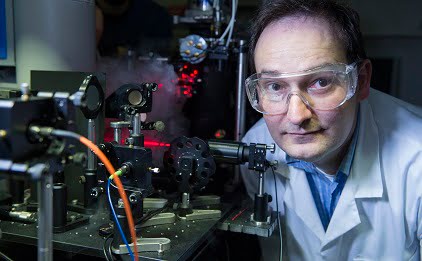As today's computers show fundamental limitations in calculation capacity for future use, a scalable, electrically driven photon source could make quantum computing a reality sooner than expected.

Researcher Emanuele Pelucchi. Courtesy of Tyndall National Institute.
Quantum computing — a technology for designing computers based on quantum mechanics, the science of atomic structure and function — uses the qubit, or quantum bit, which can hold an infinite number of values. With this capability, quantum computers would harness the capacity to superimpose information in the qubits state by encoding and operating on a few thousand properly entangled qubits.
Researcher Emanuele Pelucchi, head of epitaxy and physics of nanostructures, and a member of the Science Foundation Ireland-funded Irish Photonic Integration Center (IPIC) at Tyndall National Institute, told Photonics Media that quantum computing is the future.
“This capacity of encoding enormous amounts of information and then operating on it would simply supersede any classical computer capability we can possibly predict,” he said. “This is why we need a quantum computer: to solve large-scale problems which we cannot solve today. They need to be encoded differently from what a classical computer can or will ever be able to do.”
Pelucchi and his research team at Tyndall National Institute in Cork City, Ireland, have successfully developed a technique that enables quantum dot LEDs to produce entangled photons, which can then, in turn, be positioned where needed. The new development uses easily sourced materials and conventional semiconductor fabrication technologies.
According to Pelucchi, entangled photons are the simplest way of encoding a superposition of two qubits. The two qubits become linked in a way that when one operates, the other reacts — this is a quantum correlation.
"What we showed is that it is possible to build ordered arrays of entangled photon light-emitting diodes, providing good quality entangled photons. These would be the source of qubits in an optical quantum computer, for example, where thousands of sources operating in unison are needed,” he said. “This is the first time that such potentiality was demonstrated, while in the past only isolated devices could be obtained, that is, devices with little potential for photonic integration.”
The researcher said this is major progress in the quest for quantum computing as scientists and researchers plan for the new technology.
“There are visionary scientists who predict quantum computers will be a reality in a relatively short time scale, such as 10 or 15 years from now. However, there are extraordinary challenges to overcome first. We have provided a partial solution to one of them with this latest development at Tyndall,” said Pelucchi.
The researchers are making strides, and their photonics innovations are being commercialized across a number of sectors as a result.